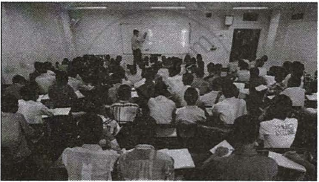Advertisements
Advertisements
Question
Solve for x and y:
`x/3 + y/4 = 11, (5x)/6 - y/3 + 7 = 0`
Solution
The given equations are:
`x/3 + y/4 = 11`
⇒4x + 3y = 132 …….(i)
and ` (5x)/6 - y/3 +7 = 0`
⇒5x – 2y = -42 ……..(ii)
On multiplying (i) by 2 and (ii) by 3, we get:
8x + 6y = 264 …...(iii)
15x – 6y = -126 ….(iv)
On adding (iii) and (iv), we get:
23x = 138
⇒x = 6
On substituting x = 6 in (i), we get:
24 + 3y = 132
⇒3y = (132 – 24) = 108
⇒y = 36
Hence, the solution is x = 6 and y = 36.
APPEARS IN
RELATED QUESTIONS
Find the value of k for which the following system of equations has a unique solution:
4x - 5y = k
2x - 3y = 12
Solve for x and y:
7(y + 3) – 2(x + 2) = 14, 4(y – 2) + 3(x – 3) = 2
Solve for x and y:
`9/x - 4/y = 8, (13)/x + 7/y = 101`
Find the value of k for which the system of linear equations has an infinite number of solutions:
2x + 3y = 7,
(k – 1)x + (k + 2)y = 3k.
Find the value of k for which the system of linear equations has an infinite number of solutions:
kx + 3y = (2k + 1),
2(k + 1)x + 9y = (7k + 1).
Find the values of a and b for which the system of linear equations has an infinite number of solutions:
(2a – 1) x + 3y = 5, 3x + (b – 1)y = 2.
Places A and B are 160 km apart on a highway. A car starts from A and another car starts from B simultaneously. If they travel in the same direction, they meet in 8 hours. But, if they travel towards each other, they meet in 2 hours. Find the speed of each car.
The larger of the two supplementary angles exceeds the smaller by 1800 . Find them.
Two straight paths are represented by the equations x – 3y = 2 and –2x + 6y = 5. Check whether the paths cross each other or not.
Read the following passage:
|
A coaching institute of Mathematics conducts classes in two batches I and II and fees for rich and poor children are different. In batch I, there are 20 poor and 5 rich children, whereas in batch II, there are 5 poor and 25 rich children. The total monthly collection of fees from batch I is ₹9,000 and from batch II is ₹26,000. Assume that each poor child pays ₹x per month and each rich child pays ₹y per month.
|
Based on the above information, answer the following questions:
- Represent the information given above in terms of x and y.
- Find the monthly fee paid by a poor child.
OR
Find the difference in the monthly fee paid by a poor child and a rich child. - If there are 10 poor and 20 rich children in batch II, what is the total monthly collection of fees from batch II?

